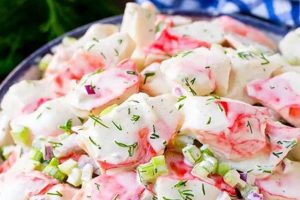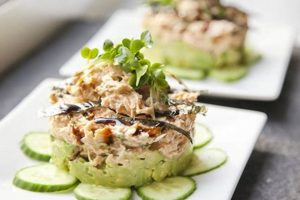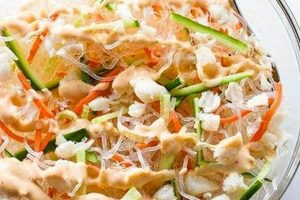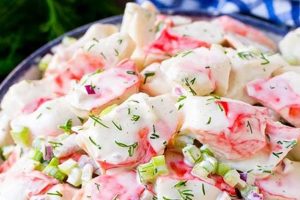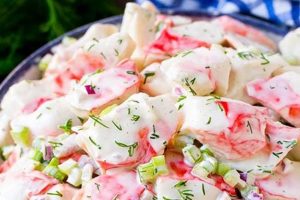A simple seafood salad typically combines cooked shrimp and crab meat with mayonnaise-based dressing. Variations often include celery, onion, and seasonings like Old Bay, dill, or lemon juice. These salads can be served chilled as an appetizer, light lunch, or part of a larger meal. An example might feature pre-cooked shrimp and canned crab, tossed with mayonnaise, chopped celery, red onion, and a squeeze of fresh lemon.
Quick seafood salads offer convenience and nutritional value. Utilizing readily available ingredients and minimal preparation time, they provide a healthy source of protein and omega-3 fatty acids. These dishes have roots in classic seafood salads, evolving to emphasize simplicity for the modern home cook. The versatility of such recipes allows for customization with various herbs, spices, and vegetables, catering to diverse palates and dietary needs.
The following sections will delve into specific ingredient selections, step-by-step preparation instructions, and suggestions for serving and presentation to create a delightful and effortless seafood salad experience.
Tips for a Delicious and Easy Seafood Salad
Optimizing ingredient selection and preparation techniques elevates a simple seafood salad from ordinary to extraordinary. Consider these tips to ensure a delightful culinary experience.
Tip 1: Quality Seafood Matters: Opt for high-quality, pre-cooked shrimp and crab meat. Freshly cooked shrimp can enhance flavor, but ensure it is properly chilled before incorporating it into the salad. Canned crab provides convenience; select a reputable brand packed in water or light brine for optimal taste and texture.
Tip 2: Enhance the Dressing: While mayonnaise serves as a base, consider additions like Dijon mustard, horseradish, or a touch of hot sauce for complexity. Fresh herbs like dill, parsley, or chives contribute bright, fresh notes.
Tip 3: Balance Texture: Finely diced celery and red onion provide a satisfying crunch. Consider adding chopped bell peppers or water chestnuts for additional textural variation.
Tip 4: Seasoning is Key: Old Bay seasoning is a classic complement to seafood. Lemon juice adds brightness and acidity, balancing the richness of the mayonnaise. A pinch of salt and black pepper enhances the overall flavor profile.
Tip 5: Chill Thoroughly: Allow the salad to chill for at least 30 minutes before serving. Chilling allows the flavors to meld and enhances the refreshing quality of the dish.
Tip 6: Presentation Counts: Serve the salad on a bed of lettuce, in a scooped-out avocado, or use it as a filling for sandwiches or wraps. Garnish with fresh herbs or a sprinkle of paprika for an appealing visual presentation.
Tip 7: Avoid Overmixing: Gentle mixing prevents the seafood from breaking down and maintains a pleasant texture.
By following these suggestions, one can achieve a balanced, flavorful, and visually appealing seafood salad with minimal effort.
These simple steps ensure a satisfying and flavorful seafood salad experience. The following section provides concluding remarks and further inspiration for culinary exploration.
1. Fresh Ingredients
Ingredient freshness significantly impacts the overall quality of an easy shrimp and crab salad. Prioritizing fresh components elevates flavor, texture, and overall enjoyment. The following facets explore the importance of fresh ingredients in this context.
- Seafood Quality
Fresh, high-quality seafood is paramount. Shrimp should exhibit a firm texture and fresh aroma, free from any off-putting odors. Crab meat should be moist and flaky, not dry or stringy. Opting for freshly cooked and chilled seafood, when possible, maximizes flavor and minimizes the risk of spoilage. Using frozen seafood requires careful thawing to maintain quality.
- Produce Vibrancy
Fresh produce contributes crispness and bright flavors. Celery and onions should be firm and vibrant in color. Limp or discolored produce detracts from both flavor and visual appeal. Utilizing freshly chopped herbs, such as dill or parsley, enhances the salad’s overall freshness.
- Dressing Enhancement
Freshly squeezed lemon juice adds brightness and acidity, balancing the richness of the mayonnaise. Minimizing the use of pre-made dressings, which can contain preservatives and artificial flavors, allows the natural flavors of the seafood and produce to shine. Incorporating freshly ground spices enhances the flavor profile.
- Shelf Life and Safety
Fresh ingredients contribute to a longer shelf life and enhance food safety. Using high-quality, properly stored components minimizes the risk of bacterial growth and spoilage. Refrigerating the salad promptly and maintaining appropriate storage temperatures are crucial for preserving freshness and ensuring safe consumption.
Prioritizing fresh ingredients ensures a superior easy shrimp and crab salad experience. The vibrancy of fresh seafood, crisp produce, and bright seasonings elevates flavor, texture, and overall enjoyment, resulting in a delightful and satisfying culinary creation.
2. Simple Preparation
Ease of preparation is a defining characteristic of this type of seafood salad. Minimal steps and readily available ingredients contribute to its accessibility for home cooks of all skill levels. This focus on simplicity aligns with contemporary culinary trends that prioritize efficiency without sacrificing flavor or quality.
- Pre-cooked Ingredients
Utilizing pre-cooked shrimp and canned or pasteurized crab significantly reduces preparation time. This eliminates the need for separate cooking and chilling processes, streamlining the overall recipe. This convenience factor makes the salad ideal for quick meals or last-minute entertaining.
- Basic Kitchen Tools
Preparation requires only basic kitchen tools, such as a mixing bowl, measuring spoons, and a cutting board. Specialized equipment is unnecessary, further emphasizing the simplicity and accessibility of the recipe. This allows for greater flexibility and reduces the barrier to entry for individuals with limited kitchen resources.
- Straightforward Techniques
The salad involves straightforward techniques like chopping, mixing, and chilling. Complex culinary skills are not required, making the recipe accessible to novice cooks. Clear and concise instructions further simplify the process, ensuring consistent and successful results.
- Adaptability and Customization
The simple nature of the recipe allows for easy adaptation and customization. Ingredients can be readily substituted or adjusted based on personal preferences and dietary needs. This flexibility makes the salad a versatile option for various occasions and palates. For example, substituting Greek yogurt for mayonnaise offers a lighter alternative, while adding different herbs or spices caters to diverse flavor preferences.
The emphasis on simple preparation directly contributes to the accessibility and appeal of this seafood salad. By minimizing complexity and maximizing convenience, the recipe offers a flavorful and satisfying meal option without demanding extensive time or culinary expertise. This simplicity broadens the appeal to a wider audience, making it an ideal choice for busy individuals or those seeking a quick and easy culinary solution.
3. Flavorful Combinations
Flavorful combinations are essential to a successful easy shrimp and crab salad recipe. The delicate flavors of seafood benefit from complementary ingredients that enhance, but do not overpower, their natural taste. This balance is achieved through careful consideration of acidity, texture, and aromatic components. The interplay of these elements creates a harmonious and satisfying culinary experience. For instance, the subtle sweetness of crab meat is often paired with the bright acidity of lemon juice, while the brininess of shrimp is complemented by the herbaceous notes of dill or chives. The creamy richness of mayonnaise provides a unifying base, binding these diverse flavors together. Textural contrast, achieved through the addition of crisp celery or red onion, further elevates the sensory experience.
Achieving optimal flavor combinations often involves balancing contrasting yet complementary elements. The richness of mayonnaise can be offset by the bright acidity of lemon juice or vinegar. The delicate flavor of the seafood can be enhanced by the subtle heat of a pinch of cayenne pepper or the aromatic complexity of Old Bay seasoning. The interplay of these contrasting flavors creates depth and complexity within the salad, preventing it from becoming bland or monotonous. Consider a salad featuring shrimp and crab with a citrus-herb dressing, incorporating grapefruit segments and chopped mint for a refreshing twist. The bitterness of the grapefruit and the coolness of the mint provide a counterpoint to the richness of the seafood and mayonnaise.
Understanding the interplay of flavors allows for customization and adaptation based on individual preferences. While classic combinations provide a reliable foundation, experimentation with different herbs, spices, and citrus fruits can lead to unique and exciting flavor profiles. This adaptability makes the easy shrimp and crab salad a versatile dish, suitable for a variety of occasions and palates. Ultimately, the success of the recipe lies in the careful balancing of flavors to create a harmonious and enjoyable culinary experience. This understanding empowers individuals to tailor the salad to their specific tastes and create a personalized culinary masterpiece.
4. Versatile Serving Options
Serving versatility significantly enhances the appeal of an easy shrimp and crab salad recipe. Adaptability to various culinary contexts, from appetizers to main courses, expands its utility and broadens its appeal to diverse dining preferences. This adaptability contributes to the recipe’s value as a convenient and adaptable meal solution.
- Appetizers and Hors d’oeuvres
The salad functions effectively as an appetizer or hors d’oeuvre. Small portions served on crackers, cucumber rounds, or endive leaves provide a light and refreshing start to a meal. Its delicate flavors and elegant presentation make it suitable for both casual and formal gatherings. For example, serving the salad in shot glasses garnished with fresh herbs offers an elegant presentation for cocktail parties.
- Sandwiches and Wraps
The salad transitions seamlessly into a sandwich or wrap filling. Its creamy texture and flavorful profile complement various breads and tortillas. Adding lettuce, tomato, and avocado enhances both flavor and nutritional value. This versatility makes it a convenient and satisfying lunch or light dinner option. A croissant filled with the salad and crisp lettuce offers a flavorful and texturally satisfying lunch.
- Salads and Bowls
Incorporating the salad into a larger salad or grain bowl adds protein and flavor. Combining it with mixed greens, quinoa, or brown rice creates a complete and balanced meal. This approach allows for customization and the incorporation of additional vegetables and dressings, further enhancing nutritional value and flavor complexity. A bed of mixed greens topped with the shrimp and crab salad, avocado slices, and a light vinaigrette offers a healthy and flavorful meal.
- Stuffed Vegetables
Utilizing the salad as a stuffing for vegetables like tomatoes or avocados offers a visually appealing and flavorful presentation. The creamy filling complements the fresh, vegetal flavors of the chosen vessel. This approach provides an elegant and healthy alternative to traditional stuffed dishes. Large, ripe tomatoes hollowed out and filled with the salad create an elegant and flavorful appetizer or side dish.
The adaptability of this easy shrimp and crab salad to various serving formats underscores its value as a versatile culinary staple. From appetizers to main courses, its adaptability caters to a range of dining occasions and preferences, making it a practical and appealing choice for both casual and more formal settings. This versatility extends its utility beyond a single dish, offering a range of culinary possibilities limited only by creativity and preference.
5. Nutritional Value
Nutritional value represents a significant benefit of easy shrimp and crab salad recipes. Shrimp and crab meat offer lean protein, essential for muscle building and repair. They also provide omega-3 fatty acids, known for cardiovascular and cognitive health benefits. These salads often incorporate vegetables like celery and onion, contributing fiber and vitamins. For example, a typical serving might contain 20 grams of protein, 10 grams of healthy fats, and various micronutrients. Understanding this nutritional profile allows for informed dietary choices and facilitates integration into healthy eating plans.
The nutritional composition of these salads can be further enhanced through ingredient selection. Opting for low-fat mayonnaise or substituting plain yogurt reduces overall fat content while preserving creamy texture. Incorporating a variety of colorful vegetables, such as bell peppers or chopped spinach, increases vitamin and mineral intake. Furthermore, portion control contributes to managing calorie intake without sacrificing nutritional benefits. A salad featuring whole-wheat crackers or a side of mixed greens adds complex carbohydrates and further boosts fiber content. Careful ingredient selection maximizes nutritional value while maintaining the convenience and flavor profile characteristic of these salads.
Recognizing the nutritional contributions of these salads facilitates their integration into diverse dietary approaches. They can serve as a valuable protein source within weight management plans, contribute to balanced macronutrient intake for athletes, and provide essential nutrients for individuals seeking healthy aging. Addressing potential concerns, such as sodium content from canned seafood, can be achieved by rinsing the crab meat before incorporating it into the salad. Ultimately, understanding the nutritional value of these easy seafood salads empowers individuals to make informed food choices and optimize their dietary intake within the context of their individual health goals and preferences.
6. Appealing Presentation
Appealing presentation elevates an easy shrimp and crab salad recipe from a simple meal to a visually engaging dining experience. Visual appeal significantly influences perception of flavor and enjoyment. A well-presented salad entices the appetite and enhances the overall sensory experience. Consider the impact of a vibrant salad composed of contrasting colors and textures: the glistening pink shrimp, the bright white crab meat, the deep green celery, and the vibrant red onion, all brought together with a creamy, pale dressing. This visual symphony stimulates the senses before the first bite is even taken. Conversely, a haphazardly assembled salad, regardless of its inherent flavor, may appear less appetizing and diminish the overall enjoyment.
Several factors contribute to an appealing presentation. Appropriate serving vessels play a crucial role. A simple white bowl provides a neutral backdrop that allows the colors of the salad to stand out. Alternatively, serving the salad on a bed of crisp lettuce adds textural contrast and visual interest. Garnishes further enhance the presentation. A sprinkle of fresh herbs, a dusting of paprika, or a wedge of lemon adds a final touch of elegance and visual appeal. Consider serving the salad in individual portions within hollowed-out avocado halves. The creamy green of the avocado complements the salad while providing an attractive and edible serving vessel. Such attention to detail transforms a simple dish into a culinary delight.
Understanding the impact of presentation on the overall dining experience allows for strategic choices in plating and serving. While the ease of preparation remains a key attribute of these recipes, dedicating a few extra moments to thoughtful presentation significantly enhances the perceived value and enjoyment of the dish. The practical application of these principles elevates even the simplest shrimp and crab salad from a basic meal to a visually appealing and memorable culinary creation. This understanding underscores the importance of visual appeal as a key component of a truly satisfying dining experience, even within the context of an easy-to-prepare dish.
Frequently Asked Questions
This section addresses common inquiries regarding easy shrimp and crab salad recipes, providing concise and informative responses to facilitate successful preparation and enjoyment.
Question 1: What type of crab meat is best suited for these salads?
While lump crab meat offers the most appealing texture, less expensive options like claw meat or backfin work well. Canned crab provides convenience, while fresh crab meat offers superior flavor. Selection depends on individual preferences and budget.
Question 2: Can frozen shrimp be used?
Frozen shrimp is acceptable, but proper thawing is crucial. Thaw shrimp overnight in the refrigerator or under cold running water. Avoid thawing at room temperature to minimize bacterial growth. Ensure the shrimp is fully thawed and patted dry before incorporating it into the salad.
Question 3: How long can the salad be stored?
Properly stored in an airtight container in the refrigerator, the salad typically lasts for 3-4 days. However, consuming it within 2 days maximizes freshness and minimizes the risk of spoilage. Monitor for any changes in odor or appearance before consumption.
Question 4: What are some alternatives to mayonnaise?
Plain Greek yogurt or a mixture of Greek yogurt and mayonnaise offer a lighter alternative while maintaining a creamy texture. Avocado can also be used to create a vegan and dairy-free version. These substitutions cater to various dietary preferences and restrictions.
Question 5: Can other seasonings be used besides Old Bay?
Old Bay is a classic choice, but experimentation with other seasonings is encouraged. Dill, paprika, garlic powder, onion powder, or cayenne pepper can be used individually or in combination to create diverse flavor profiles. Fresh herbs like parsley, chives, or tarragon also offer flavorful alternatives.
Question 6: How can sodium content be reduced?
Rinsing canned crab meat under cold water before use helps reduce sodium content. Using low-sodium mayonnaise or preparing a homemade dressing allows for greater control over sodium levels. Monitoring overall seasoning and avoiding excessive salt further minimizes sodium intake.
Understanding these common concerns facilitates successful preparation and enjoyment. Thoughtful ingredient selection and proper storage techniques ensure a safe and delicious culinary experience.
The following section offers a concluding summary and encourages further exploration of easy shrimp and crab salad recipes.
Conclusion
Exploration of easy shrimp and crab salad recipes reveals their accessibility, versatility, and nutritional value. Emphasis on fresh ingredients, simple preparation, and flavorful combinations yields a dish suitable for various occasions. Adaptable serving options, from appetizers to main courses, broaden culinary potential. Nutritional benefits derived from seafood and incorporated vegetables contribute to healthy eating patterns. Attention to presentation elevates the dining experience, transforming a simple salad into a visually appealing culinary creation. Understanding these facets optimizes preparation and enjoyment.
Culinary exploration often involves balancing simplicity and flavor. Easy shrimp and crab salad recipes exemplify this balance, offering a convenient yet satisfying culinary experience. Continued experimentation with ingredients and presentation further enhances enjoyment and expands culinary horizons. This accessible and adaptable dish holds significant potential within the modern culinary landscape.

